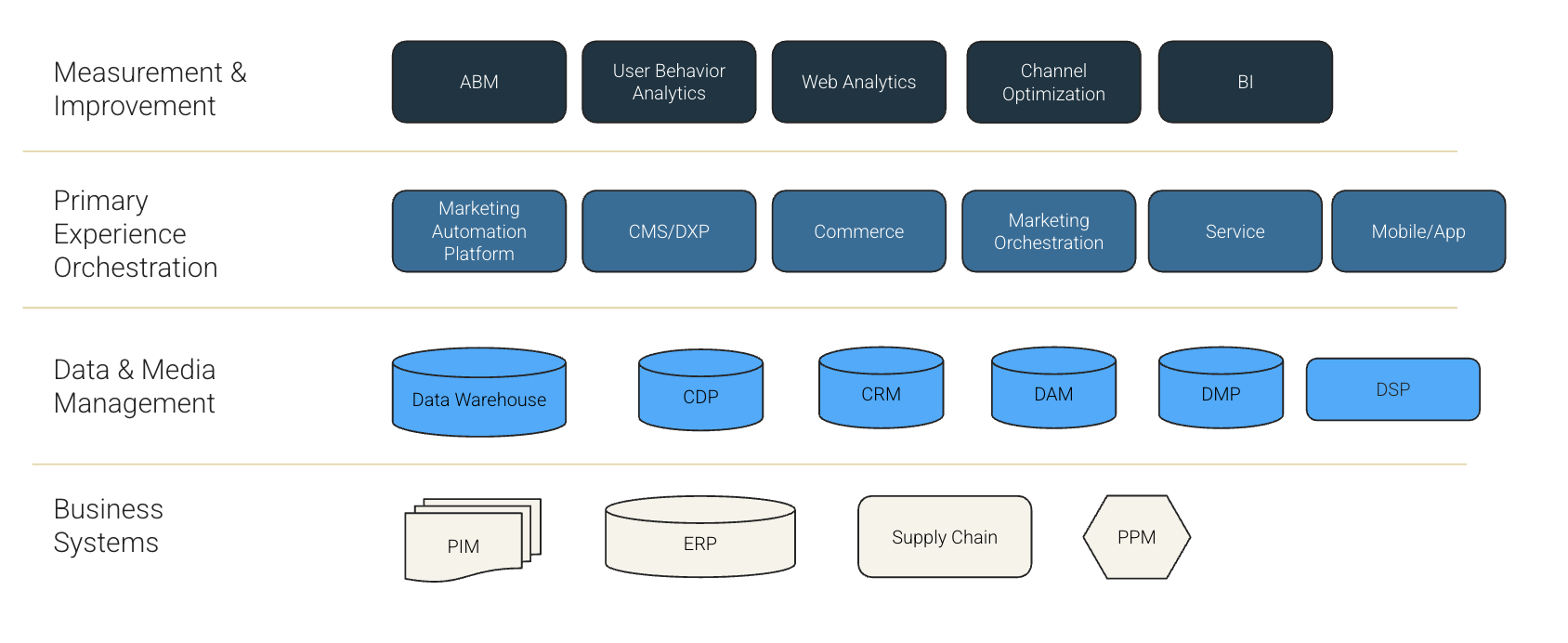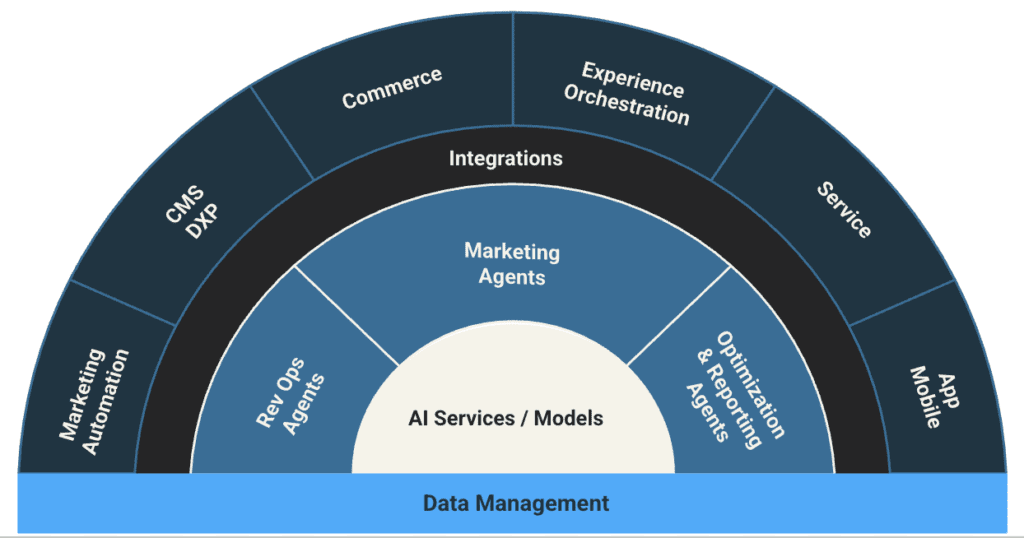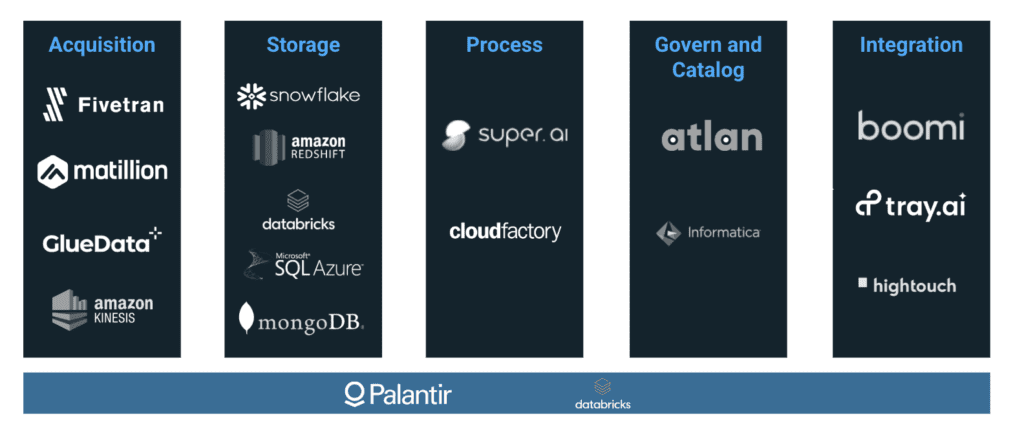AI is the New OS: Prepare for a Marketing Revolution

The marketing technology landscape is on the cusp of a monumental shift. Forget AI as just another tool in your ever-growing tech stack. We’re entering an era where Artificial Intelligence isn’t just enhancing our operations – it’s becoming the very operating system that powers our businesses.
The “Composable SaaS Stack”
Let’s take a moment to visualize your current marketing ecosystem. It likely looks something like this:
- A CRM diligently managing customer relationships.
- Marketing automation platforms (MAPs) orchestrating omni-channel campaigns.
- Analytics tools meticulously measuring performance.
- Content management systems (CMS) web platform delivering digital experiences.
- And a Customer Data Platform (CDP) striving to unify it all.

This “composable SaaS stack” approach, connecting various specialized platforms through integrations, offered significant advantages in terms of flexibility and scalability. However, in today’s rapidly accelerating digital world, this interconnected web is starting to show its limitations. The inherent fragmentation, the complexities of managing numerous integrations, and the sheer operational overhead are creating friction, hindering the very agility these architectures were meant to provide.
But a powerful new force is emerging: agentic AI.
This isn’t just about adding smart features; it’s about building unified, intelligent systems capable of autonomous reasoning and decision-making that transcend the boundaries of traditional platforms. We’re witnessing a rapid acceleration towards self-optimizing ecosystems that dynamically adapt to business needs, promising to replace the manual orchestration of composable architectures.
While our current SaaS landscape has served us well, the increasing demands for real-time personalization, seamless customer journeys, and deeply data-driven decisions are pushing these traditional architectures to their breaking point.
The Fork in the Road: AI as an Add-on vs. AI as the Foundation
When it comes to integrating AI, businesses are currently facing two distinct strategic paths, each with profound implications for future growth and competitive advantage:
Above the Stack: Tactical AI Enhancement
This approach treats AI as an overlay, a layer of intelligence applied on top of your existing SaaS platforms. Think of it as adding smart features to your current toolkit:
- Augmented Intelligence: AI assisting human decision-making within established workflows.
- Feature Enrichment: Existing platforms gaining intelligent capabilities.
- Tactical Optimization: AI improving specific performance metrics within individual systems.
- Workflow Automation: Intelligent automation streamlining repetitive, low-level tasks.
While this tactical deployment of AI can deliver valuable improvements, it often results in “islands of intelligence” operating within the constraints of your current technology ecosystem. The gains, while noticeable, tend to be incremental rather than truly transformative.
Below the Stack: Strategic AI Foundation
This is the more radical and ultimately more impactful approach. Here, AI is positioned as the fundamental layer beneath your SaaS infrastructure – a true cognitive operating system that powers all aspects of your business:
- Unified Intelligence: A cohesive AI foundation integrated across all platforms.
- Cross-platform Orchestration: Seamless coordination and communication between disparate systems, driven by AI.
- Predictive Operations: AI anticipating needs and identifying opportunities across the entire enterprise.
- Autonomous Action: Systems empowered to self-optimize and make decisions across functional boundaries.
This foundational approach breaks free from the limitations of individual platforms, creating an intelligent substrate that unlocks previously unimaginable capabilities and fosters exponential, not just incremental, growth.
Bracing for a Bold Prediction
Within the next five years, it’s highly probable that many traditional SaaS platforms will undergo significant evolution, with some becoming obsolete in their current form. AI as an Operating System (OS) is poised to emerge as a dominant model shaping how companies and organizations operate their businesses.
3 Powerful Tides Shaping the Future of MarTech
This monumental shift towards AI being at the foundation of your technology stack isn’t a sudden, isolated event. Rather, it’s the powerful convergence of several key trends that are rapidly reshaping the technological landscape and driving this profound transformation. As you navigate the currents of martech’s future, understanding these three key tides will provide invaluable insight into the forces taking shape:
1. The Rise of AI as the Operating System:
Think beyond AI as simply a feature within your existing marketing, sales, and design platforms. Imagine it as the central intelligence – the very operating system – that orchestrates your entire technology ecosystem. Just as foundational systems like Windows or macOS provide the framework for your computer applications, AI is evolving into the cognitive engine driving business operations. In practical terms, this means:
- Instead of manually configuring marketing campaigns, AI agents autonomously optimize and execute them based on real-time data.
- Moving beyond reactive customer service, predictive AI systems anticipate and address customer needs before they even arise.
- Marketing content isn’t just distributed; it’s dynamically generated and personalized in real-time for individual users.
2. The Data-Centric Revolution:
We’re experiencing a fundamental change in architectural thinking, shifting our focus from individual applications to a central emphasis on data with centralized ecosystems, like Adobe, to support. Envision your organization’s data not as isolated silos within disparate systems, but as a unified, intelligent resource that flows seamlessly and securely to where it’s most valuable. Key aspects of this shift include:
- Universal and readily accessible data across all relevant systems
- Real-time intelligence and decision-making fueled by readily available data.
- Enhanced data governance and compliance built into the foundation.
- Flexible service composition based on dynamic data requirements.
3. Data as Rocket Fuel:
Data is no longer a mere byproduct of our operations; it has become the essential catalyst that powers business intelligence and drives competitive advantage. This critical evolution demands a more strategic and sophisticated approach to data management, emphasizing key areas of need like:
- Advanced data organization and rigorous quality management are paramount.
- Real-time data activation capabilities are crucial for immediate insights and actions.
- Intelligent governance frameworks ensure data integrity and responsible use.
- Automated data preparation streamlines the process of feeding data to AI models.
Building the Bridge to Tomorrow: Your Transition Strategy
The journey to an AI-powered future isn’t about a disruptive “rip and replace” of your current infrastructure. It’s about strategically building intelligent bridges between your existing capabilities and the immense potential of tomorrow. Here’s how forward-thinking organizations are navigating this transition:
Enhancing Current Systems
Your existing SaaS platforms aren’t disappearing overnight. Instead, they are being progressively augmented with AI capabilities:
- Marketing automation platforms integrating predictive analytics for campaign optimization.
- CRM systems adding intelligent customer insights and next-best-action recommendations.
- Content management systems featuring AI-powered personalization and content generation assistance.
Developing the Data Foundation
A strong, unified data foundation becomes the bedrock of your future AI-powered operations:

- Customer Data Platforms (CDPs) playing a crucial role in unifying customer information from various sources.
- Scalable data warehouses providing the necessary storage and processing power.
- Master Data Management (MDM) ensuring data accuracy and consistency across the organization.
- Robust integration layers seamlessly connecting diverse data sets and systems.
Implementing AI Services “Below the Stack”
With AI Operations and Models at the core, you’ll see the rise of:

- Leveraging Large Language Models (LLMs) for more natural and effective customer interactions.
- Employing machine learning for advanced predictive analytics and forecasting.
- Utilizing computer vision for enhanced content understanding and analysis.
- Deploying autonomous agents for automated operations and optimized business functions across the board.
Real Business Impact: The Tangible Benefits
This isn’t just abstract theory. Organizations are already experiencing the tangible benefits of this AI-driven transformation. This includes some of the familiar marketing, product, and business use cases below and more:
- Personalization at Scale Examples
- Marketing campaigns that dynamically adjust based on real-time performance and individual customer behavior.
- Content that adapts in real-time to individual user preferences and context.
- Product recommendations that truly understand and anticipate customer needs.
- Operational Excellence Examples
- Automated workflows that continuously optimize themselves for maximum efficiency.
- Resource allocation that intelligently predicts and adapts to fluctuating demands.
- Real-time performance monitoring and autonomous adjustments to ensure optimal outcomes.
- Enhanced Customer Experience Examples
- Natural and intuitive conversations with AI-powered service agents.
- Proactive problem resolution, addressing potential issues before they impact the customer.
- Seamless and consistent experiences across all touchpoints and channels.
Future-Proofing Your Business: Preparing for an AI-Fueled Future
Getting your organization ready for the age of AI isn’t a future concern – it’s a strategic imperative now. Even if your current SaaS solutions feel robust, taking proactive steps will not only pave the way for a more deeply integrated AI technology stack but will also yield significant improvements in operational efficiency, data accuracy, and overall productivity today. Consider these key activities as foundational best practices, with or without AI taking center stage.
Lay the Groundwork: Data Readiness is Paramount
Think of your data as the fuel for the AI revolution. To capitalize on the future where one-third of enterprise applications will boast autonomous AI capabilities, a solid data foundation is non-negotiable. Start by:
- Conducting a thorough audit of your current data quality, accessibility, and governance. Understand where your data resides and its reliability.
- Implementing robust data governance frameworks to ensure data integrity, compliance, and ethical use of information.
- Building scalable and reliable data pipelines to facilitate seamless data flow between systems, ensuring AI has access to the information it needs.
- Developing clear data taxonomies and standards for consistent data interpretation across your organization, a crucial element as 15% of daily business decisions become fully automated by AI systems.
Architect for Agility: Embrace Evolutionary Design
Your technology architecture needs to be adaptable to the coming wave of entirely new AI-native platforms designed from the ground up. Prepare for this evolution by:
- Adopting API-first approaches to enable seamless integration and interoperability between existing systems and future AI-powered solutions.
- Implementing event-driven architectures for real-time data processing and responsiveness, allowing your systems to react intelligently to dynamic changes.
- Building scalable and flexible data platforms capable of handling the growing volumes and complexities of AI-driven data.
- Enabling real-time data processing capabilities to unlock immediate insights and power AI applications that demand up-to-the-second information. This agility will be key as traditional SaaS models either evolve significantly or face obsolescence.
Empower Your People: Cultivate an AI-Savvy Team
Technology alone isn’t the answer; your team needs to be prepared to leverage the power of AI. Invest in:
- Building AI literacy across your entire organization, ensuring everyone understands the fundamentals and potential of this transformative technology.
- Establishing centers of excellence focused on AI adoption and innovation, fostering expertise and driving strategic implementation.
- Fostering a data-driven culture where insights inform decision-making at all levels, creating an environment where AI-powered recommendations are valued and understood.
- Developing new skills and capabilities in areas like data science, AI engineering, and machine learning operations to build the internal expertise needed to thrive in an AI-centric world. This proactive skill development will be essential to navigate the evolving technological landscape.
The Path Forward: Embrace the Cognitive Revolution
This isn’t just another fleeting technology trend; it’s a fundamental reimagining of how businesses operate and interact with their customers. Success in this new era requires more than simply implementing new tools. It demands a fundamental shift in your thinking about technology architecture, data strategy, and customer engagement.
The organizations that will thrive in this cognitive future are those that can effectively combine:
- Strong and well-governed data foundations.
- Powerful and seamlessly integrated AI capabilities.
- Clear and strategically aligned business objectives.
- Adaptive and forward-thinking organizational cultures.
The future of marketing technology is cognitive, connected, and continuously evolving. The question isn’t whether to embrace this transformation, but how quickly and effectively you can make the journey. The time to start building your AI-powered foundation is now. Remember, this isn’t about replacing human intelligence – it’s about augmenting it. By building an AI-powered foundation today, you are creating the ecosystem for tomorrow’s innovations and unprecedented opportunities.





